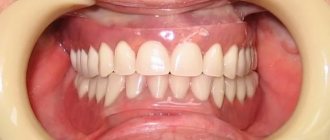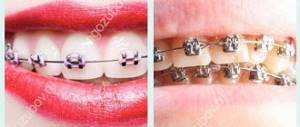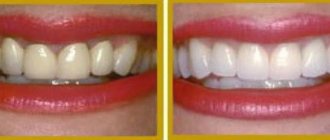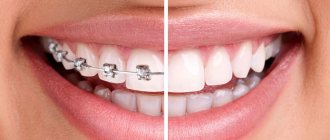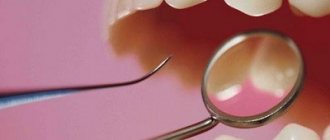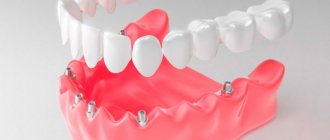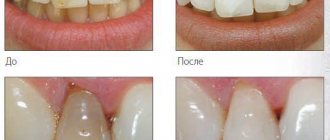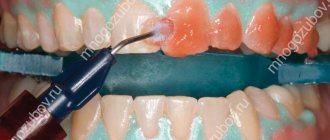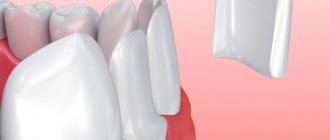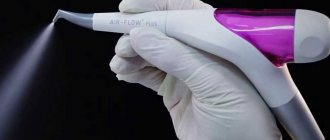When making dental prosthetics in dentistry, various materials and restoration technologies are used. One of the traditional materials, tested for decades, is gold. The qualities of elasticity, durability and strength are indicators that explain this choice.
It is this metal that can provide comfortable chewing of food for a long time and not deform. In addition, it is not an environment in which pathogenic microorganisms develop.
Features of gold crowns: what they are, how to install and remove them
Article navigation
- Use of gold in dentistry
- Features of pure gold prostheses
- Types of gold dental crowns
- Advantages and disadvantages of prostheses
- Indications for installation of crowns made of precious metals
- Who should not get gold prostheses?
- Features of making prostheses
- How does the installation work?
- Adjustment period: main problems
- How to remove a gold crown
- Who gets the crown after removal?
- Is it possible to clean the crown from glue residues?
- Features of product care
- How long can the product be used?
Question for a specialist
Until recently, a smile with a golden sheen was considered an indicator of the owner’s presentability and wealth.
Gold crowns, due to the safety and softness of the material, were extremely popular, and the durability of the products is still demonstrated by representatives of the older generation. Meanwhile, modern materials used in dental prosthetics better meet aesthetic requirements. Why do many people prefer gold, what are the features of such products, how to clean gold crowns from residues - more on this and much more later in the article.
Tattoos and highlighting are the fashion of the future
In many ways, our fashion is determined by technological progress, and now this is especially noticeable. For example, not so long ago in Japan they came up with the idea of placing a small light bulb in the mouth to illuminate the smile from the inside and make it literally radiant.
Another modern trend appeared back in 1979, when American Steve Huerd invented and patented the technology of applying tattoos to enamel. It is noteworthy that at that moment the new product did not find widespread popularity, but it gained recognition quite recently. Now tattoo blanks are sold all over the world for about $40 each. A similar service is also offered in some Russian dental clinics.
Trends are constantly changing, and sometimes they take people to terrifying extremes. But healthy, strong teeth will always be in fashion. To keep your smile beautiful and radiant, maintain oral hygiene and remember to visit the dentist for preventive maintenance every six months.
1Petrikas, A.Zh. Beauty, smile, art, dentistry, 2013.
Features of pure gold prostheses
Pure metal is not used to make gold “caps” - due to its high softness, it is not suitable for replacing natural teeth. As a rule, they use 900 and 750 gold, combining it with other elements (silver, copper, platinum), achieving the desired properties. By adding cadmium and brass, a 750 alloy is obtained, which is used as a solder to join individual parts of the prosthesis.
BEST REMOVABLE DENTURE - 20,000 rub.
All manipulations for the manufacture, installation and fitting of the prosthesis, including impressions, are included.
Save RUB 10,000! >> Call now or request a call
Opening hours: 24 hours a day - seven days a week
Apart from the aesthetic side of the issue, gold is an ideal material for dental reconstruction. It is not susceptible to rust, does not react with other metals, and does not cause allergies. Exceptional strength is combined with softness: the product tightly covers the patient’s own tissues, leaving no gaps for infection.
Another feature of gold crowns that allows their use in dentistry is the rate of compression and expansion of the precious metal, which is identical to that of one’s own dental tissues. This makes it possible to avoid the appearance of cracks and metal separation from the base during operation of the product.
Moreover, gold dentures are resistant to natural and artificial dyes, do not darken, and maintain a smooth structure for a long time.
We will definitely help!
The circumstance when the crown came off was not a pleasant one. The patient experiences many problems - from difficulties chewing food to psychological discomfort. The absence of an element in the mouth affects the smile and diction: often a person begins to lisp or involuntarily whistle, which is why he tries to reduce communication with others to a minimum. Complexes arise, problems appear in the family and at work. Nowadays, it is difficult to achieve serious success without a well-groomed appearance and good health, the indicator of which is a beautiful smile. This means that the circumstances under which the crown may fall off must be excluded. This will be done by the experienced dentists of our clinic, who have had to deal with similar cases more than once. The main thing is to identify the correct cause, which X-rays will help with. When the crown comes off, the doctor will put the prosthesis in place if everything is fine with it, or make a new one if it is deformed. If the cause is in the tab, treatment will be required. In any case, our employees will make every effort to quickly and painlessly restore the integrity of the dentition.
- We use modern technologies and the latest generation drugs.
- We employ dentists with higher education and extensive experience.
- We comply with strict hygiene requirements and sanitary standards.
- Each department has its own laboratory facilities.
- The cost is quite affordable, many services can be obtained free of charge under compulsory medical insurance.
- There is a flexible system of discounts, and it is possible to pay for treatment in installments.
- The branches are located in close proximity to metro stations.
- We work seven days a week and on holidays, and visitors are always welcome.
An official contract is concluded with each patient and a guarantee is provided. We try to approach each case individually, understanding how unpleasant the episode when the crown comes off is. Restoring aesthetics and functionality is the responsibility of dentists, which our doctors treat with reverence and care. It is important to establish informal contact with the client - without mutual trust it is difficult to achieve success in any business. During the period when a crown has fallen off, the moral support that the staff of the VivaDent clinic tries to provide to each visitor is especially important. That is why there are so many grateful reviews from patients whom we have helped. If a crown has fallen off, we invite you to any of our branches. Consultants will help you choose the nearest one and sign up for a convenient time by phone or using the online form on the website. Our doors are always open to visitors!
Types of gold dental crowns
There are two types of gold crowns for teeth:
- stamped - considered an outdated method of prosthetics made from industrial blanks (sleeves) or plates. They have a lot of disadvantages: lack of aesthetics, risk of gum injury, loose fit, the need to use a large amount of cement, in which gaps form over time,
- solid cast - a more modern method, which is based on the use of special equipment. They make it possible to exactly replicate the contour of a natural tooth, do not cause harm to soft tissues, and are characterized by a long service life. Among the disadvantages is the need to grind down a large amount of the tooth before installation.
In addition, gold products can be partially or completely covered with ceramics (metal-ceramic products), but they belong to a different type of prosthetics.
Kinds
Full
Complete – covers the tooth surface completely. Can be made using stamping from preliminary blanks. This method is rarely used. The one-piece manufacturing method is more often used. The monolith repeats the anatomy of its tooth. The technology is imperfect due to the need for preparation.
Half crown
Half-crown - a partial crown is a non-removable structure that covers the tooth on four surfaces: oral, lateral and incisal. The buccal or labial surface remains free. This type of crown is placed on premolars and front teeth. Another name is three-quarter, although in fact the product covers 4/5 of the tooth surface.
The structure can be used as a supporting element of a prosthesis (bridge, brugel) or as part of a splint.
Equatorial
Equatorial – covers the crown part of the tooth. This type is used when erasing enamel, as a support for splinting and as an element of bridge prostheses.
Stump
A stump crown is a deep structure for restoring a completely or partially destroyed tooth.
With metal-ceramic coating
Gold crown with metal-ceramic coating. The method is based on the production of a frame made of gold, which is covered with ceramic mass. This is done primarily for aesthetic purposes.
Pin
A crown on a pin is installed in case of complete loss of a tooth. The base, frame or entire prosthesis can be made of gold with or without a metal-ceramic coating.
Advantages and disadvantages of prostheses
Why do they put gold crowns on teeth? Products made from this metal have many advantages over other materials:
- have high antibacterial properties,
- do not cause allergies,
- do not lead to galvanic effect,
- have a long service life,
- characterized by increased strength,
- high plasticity rates make it possible to tightly fit the prosthesis on a unit of the dentition,
- do not have a negative effect on the enamel layer of neighboring teeth,
- do not cause irritation or increase sensitivity of soft gum tissues,
- the alloy does not contain any components harmful to health,
- do not oxidize,
- can be used for prosthetics of any unit of the dentition.
At the same time, one cannot fail to note some negative aspects of using gold crowns. For example, installing such products on the front teeth cannot be called aesthetic. In addition, the cost of gold prostheses is not affordable for all patients. They are often more expensive than even zirconium dioxide.
Snow-white Hollywood smile
When answering the question about what teeth are in fashion now, one cannot fail to mention veneers and lumineers. Today, most people in the world admire the beautiful snow-white smiles of popular stars. It is not always possible to achieve the same dazzling effect with the help of in-office whitening, because it is important that the teeth are not only white, but also smooth and beautifully shaped. Veneers allow you to make your smile irresistible, and in a fairly short time.
Veneers are very thin plates that are created from composite, dental ceramics, glass ceramics or zirconium dioxide. They are fixed using an adhesive system on the front side in the smile area. Such overlays give the incisors and canines the correct shape, make the teeth perfectly white, even and beautiful, hide the gaps between the teeth and mask slight curvature. The only caveat is the need to grind the enamel before installing them. But there is a solution here too - lumineers. These are even thinner plates, the fixation of which often does not require preparation.
The fashion for veneers dates back to the 30s in Hollywood. Then dentist Charles Pincus first came up with the idea of decorating the smiles of actors and actresses with porcelain plates to make them ideal for close-up filming. Such plates did not last long - they were fixed only for beautiful shots. It was only in the 80s that composite adhesive and the technology of etching contact surfaces were invented. It is now possible to fix veneers for a long time1.
Veneers can make your smile irresistible in a short time.
Indications for installation of crowns made of precious metals
A gold crown can be placed if the following indications exist:
- violation of the anatomical shape of the tooth,
- increased abrasion of the enamel layer,
- bruxism,
- if you are allergic to other, inexpensive alloys, in particular medical steel or nickel,
- the need for additional strengthening of the dental unit,
- tooth decay (usually the chewing group).
Some patients insist on using gold when undergoing dental prosthetics, so such a product can be installed at will.
Example subheading, maximum number of lines 2
- example of using points
- example of using points
- example of using points
- example of using points
The central topic of discussion was the basic concept of the ALL-ON-4 “all on four” technique, the essence of which is the use of four dental implants. This is a method of full denture prosthetics in the absence of all teeth. Note that the ALL-ON-4 method is an alternative to classic removable dentures. The central topic of discussion was the basic concept of the ALL-ON-4 “all on four” technique, the essence of which is the use of four dental implants. This is a method of full denture prosthetics in the absence of all teeth. Note that the ALL-ON-4 method is an alternative to classic removable dentures.
The second day was devoted to a live operation, which was jointly performed by specialists - Liliya Sterligova and Alexander Bikbaev with Spartamed doctors. This contributed to consolidating the acquired skills in practice. The patient received a prosthesis immediately after implantation.
The main objectives of the Spartamed clinic are the professional growth of doctors and the provision of highly qualified medical care to patients at all stages of treatment.
We believe that comfortable treatment is impossible without the patient's trusting attitude. The Spartamed dentist will conduct an examination, tell you in detail how the treatment will be carried out, and discuss with you the features of using various techniques and the economic component of the treatment. The doctor will separately discuss pain relief options, so even complex manipulations will take place without pain and stress. Make an appointment for effective and high-quality treatment.
Features of making prostheses
The process of making a gold crown depends on the type of product:
- stamped - based on X-ray data, a plaster blank is made in a dental laboratory, which is subsequently transferred to a gold sleeve. Using special tools and equipment, the specialist gives the precious metal product the desired shape and size, and then sends it to the clinic,
- solid cast - the orthopedic dentist takes impressions of both jaws, on the basis of which a wax model of the future product is made in the dental laboratory. Using a wax blank, the technician casts a gold crown and adjusts it to the specified parameters.
Throughout the entire manufacturing period, the patient is provided with a temporary structure.
Gold-containing alloys used in Dial-Dent
Modern dentistry uses many different alloys, including those containing gold in different percentages. Family Dental specialists have chosen the highest quality products for their patients. These alloys lend themselves well to processing and polishing, and when finished, products made from them are strong and reliable. The following alloys are used in Dial-Dent:
Degulor M® (gold – 70%, platinum – 4.4%, palladium – 2%, silver – 13.5%, copper – 8.8%, zinc – 1.2%, iridium – 0.1%)
Degudent H® (gold – 84.4%, platinum – 8%, palladium – 5%, indium – 2.5%, tantalum – 0.1%)
BiOcclus N® (gold – 85.6%, platinum – 11.9%, zinc – 1.6%, iridium – 0.1%, rhodium – 0.2%)
Commentary by dental technician D.V. Volk: “Gold-containing alloys are convenient to work with. With their help, you can make quite complex structures, they are perfectly modeled and combine well with various ceramic masses. The resulting crowns look exactly like natural teeth thanks to the yellow color of the alloy, which shines through the ceramic.”
Comment from dental technician Golovin E.N.: “As a technician who has been working for many years, I can say with confidence that a clasp denture with a telescopic fixation system, made of a gold-containing alloy, will be maximally functional, since gold has a high modulus of elasticity, and this increases precision in manufacturing."
How does the installation work?
The installation of gold crowns can be generally described as follows:
- on a previously prepared tooth (ground to 0.5-1 mm, depulped), a prosthesis obtained from the laboratory is tried on, if necessary, it is adjusted,
- check the density of shrinkage and the correct closure of the teeth, while the patient should not feel discomfort,
- fix the product with dental cement.
You need to remember that you cannot get a gold crown in the first clinic you come across. To manufacture and install such products, a medical institution and laboratory must have a license. In addition, the specialist must have at least 5 years of work experience in this field.
Dishwashing liquid
Dish cleaning products contain active substances that remove even the most stubborn stains. They can be used to wash not only plates and pots, but also jewelry. Pour warm water about 38-40 °C into a container, add a few drops of liquid dishwashing detergent and stir. Do not use hot or boiling water, especially if your jewelry contains fragile gemstones: they may crack or change color when exposed to high temperatures. Soak gold items in the solution for about 20-30 minutes. Take them out and scrub them with a toothbrush with the softest bristles to remove dirt in hard-to-reach places. Rinse the gold with tap water and blot dry with a soft cloth.
Lemon
Lemon is famous for its cleansing properties. The citric acid contained in this citrus perfectly removes dirt from jewelry without damaging it. To restore its original appearance and characteristic shine, thoroughly rub the gold with a slice of lemon and then rinse with water. Wipe them with a paper towel and leave to dry. Finish by polishing with a soft cloth.
Adjustment period: main problems
Immediately after installation, you should not drink or eat for about 2 hours (the dentist will indicate a more precise time, since the duration of the period of abstinence depends on what type of cement was used for fixation). There are no special requirements regarding lifestyle changes.
In some cases, while getting used to the structure, the patient may encounter problems such as pain and discomfort, and increased tooth sensitivity. You must inform your dentist who performed the installation about any unusual or unpleasant sensations. It may be necessary to correct the position of the crown, or the situation is temporary, and the use of special products (rinse aid, paste) will be sufficient.
It will take some time to get used to, during which it is advisable to avoid eating solid foods so as not to accidentally damage your cheek or tongue.
Metal crowns: affordable prosthetics
Crowns of this type are made from alloys of gold, platinum, titanium, and steel. The presence of spraying is optional and is selected individually.
Stamped products are characterized by low cost, as well as lack of sufficient strength and anatomical fidelity. Because of this, irritation of soft tissues may occur, which will be injured by the edges of the crown. It is also possible for food to get and get stuck under the edges of the crown if it does not fit tightly. This can cause inflammation and discomfort. However, these problems will not occur if the crown is made by a master with extensive experience.
Metal crowns made using a one-piece casting method are characterized by increased wall strength. The material is formed in layers. This allows the denture to withstand more chewing load. Solid crowns require grinding for maximum ease of use.
Most often, metal crowns are used when a prosthesis is needed for chewing teeth located out of sight.
How to remove a gold crown
Removal of the structure is carried out strictly according to indications:
- expiration of service life,
- malocclusion,
- crown damage,
- carious lesion under the product,
- inflammation of the oral mucosa.
Gold caps can only be removed from teeth using a special device. For this purpose, forceps, ultrasonic and pneumatic equipment are used that destroy the material on which the product is fixed, and crown removers. As a rule, in a clinical setting, the question of how to separate a crown from a tooth does not arise, since the product is removed only after the cement has been destroyed. It is highly not recommended to carry out the procedure yourself - this can lead to damage to the soft and hard tissues of the gums and teeth.
Black teeth as an “original” highlight
In our modern understanding, there can only be one tooth color in fashion – immaculate white. Russian beauties believed the same thing in the 16th century, and they began to actively use “mercurial white” - mercury - to whiten enamel. After the procedure, the smile did become snow-white, but not for long. The enamel quickly darkened and collapsed. This is how the fashion for black teeth appeared in Rus'.
A similar trend at one time appeared in Japan, as well as in many other countries of Southeast Asia. There, married ladies deliberately blackened their smiles in order to demonstrate their fidelity to their husbands. The enamel was covered with a special black varnish, and the longer it lasted, the more devoted the wife was considered. The tradition is called ohaguro, and it has existed in those countries since time immemorial.
Who gets the crown after removal?
Patients often wonder whether the dentist should give away a gold crown. Yes, after removing the product, the doctor hands it over to the patient, because the gold alloy itself has already been paid for by the patient. The following question is often asked: how to remove teeth from gold crowns that were “inherited”? Here again, you should contact a dental technician in the laboratory if you want to keep the metal in good condition. Or try to gently tap with a hammer. But in any case, you will have to remove the remaining cement, so it is better to immediately contact a professional.
Patient reviews
And I like gold teeth. This has always been considered an indicator of financial importance. I still have dentures from my grandmother; I can take them to a pawnshop. You just need to find out how to clean gold crowns from your teeth and check what kind of gold dental crowns are made of. But I wouldn’t put one on myself, because it’s unfashionable now.
Sergey, St. Petersburg
I am against gold teeth. They look unnatural. But last year I knocked out my front tooth during training. I went to the dental clinic and, as it turned out, not all dentures suit me. The dentist recommended inserting a gold tooth. I doubted it very much, but there were no other options for me. It turns out that they are placed for medical reasons. Especially if there are problems with the kidneys or liver.
In addition, gold dentures last about 15 years. You just need to take proper care of them. I asked what type of dental crowns are used. The doctor explained that gold teeth are of high standard and joked that this is a good investment.
Maxim, Nizhny Novgorod
Several years ago, on the recommendation of a doctor, I had gold teeth installed. It’s good that they are not front, so they don’t interfere with the aesthetics of the look. Gold interacts well with gums and does not cause discoloration. I didn't have any allergic reaction. I know that such teeth do not cause any negative reaction in the body. They are placed if the patient has significant stomach problems. Coated teeth often cause various complications.
However, I think that from time to time it is necessary to take pictures to make sure that everything is in order with the teeth.
It's just for insurance. And so they will serve for at least 10 years, or even more. Marina, Orel
Is it possible to clean the crown from glue residues?
When a gold crown is removed or falls out, cement residues remain on it. If the desire to install the precious prosthesis again does not arise, it can be sold for purchase. But before this, the product must be cleaned of the fixing material. To do this, use special products that dissolve dental cement, which can be purchased at a specialized store. But it is best to take the denture to a dental laboratory or contact the doctor who installed it. Of course, you will have to pay for this separately.
How long can the product be used?
Gold crowns have a long service life - 15-20 years. Careful attitude and appropriate hygienic care can extend it to 25. But again, you need to look at the condition of both the supporting and opposing teeth. Nothing will happen to the crown itself during this time, but the rest, the living tissues, gradually fail. This explains the need to replace the prosthesis.
Despite the numerous advantages of using gold crowns in dental prosthetics, today dentistry still offers more advantageous options for crowns. For example, those made on the basis of zirconium dioxide or metal-ceramic on a gold basis. Such dentures will not only be strong and durable, but will also add naturalness and aesthetics to your smile.
Author: Sambuev B. S. (Thank you for your help in writing the article and the information provided)
What type of denture can be used for the upper jaw?
Crowns
This non-removable type is used when the tooth is destroyed, but the root part is healthy (otherwise it is installed on an implant). The main tasks of the crown are to protect against further destruction and restore function. In modern dentistry, the following options are most often used:
- the most popular are metal-ceramic (metal frame with ceramic lining), metal-free or zirconium dioxide
. They have high strength and excellent aesthetics - indistinguishable from your own tooth; - cast metal crowns
are also sometimes used . They are quite durable, but visible in a smile and conversation; - stamped metal ones
are the cheapest, but short-lived and noticeable, and therefore are not used so often.
Life time
– from 3 years for stamped ones, up to 10-25 years or more for zirconium dioxide and metal-ceramic. Among the latter, frames made of titanium and an alloy of palladium and gold are particularly durable.
Dental bridge
Fixed technology to compensate for several adjacent lost teeth - from 1 to 4. Consists of two crowns, between which artificial units are located. The structure is installed on your own (supporting) teeth, and if they are missing or in poor condition, on implants. The most popular types of dental bridges are metal-ceramic, metal-free, and zirconium dioxide. They are strong enough to be used on painters and provide optimal pressure on the gums. Service life is from 10-15 years. Among the advantages of this technology:
- invisibility
– can be used even on the most visible areas of the upper jaw; - high level of restoration
of chewing functions; - comfort
for the patient - a minimum of contraindications, a short period of adaptation (from several hours to several days), after which the bridge completely ceases to be felt.
